#like is c3 going to get worse or do I just share a different opinion than most of the fandom?
Text
I find it v interesting (/slightly worrying) that I've heard numerous comments of ppl "getting bored of" or otherwise not enjoying c3 enough to keep up with it, but I'm enjoying it so much so far?? Granted I'm still fairly early on (ep 31) but tbh I've enjoyed this campaign so far more than I did for c2 at the same point. Which is interesting since general consensus is that c2 is most ppls fave campaign? Idk I find it v curious.
#ignore me#maddie liveblogs cr3#I'm worried that my opinion will change over the course of c3 and that makes me nervous :(#like is c3 going to get worse or do I just share a different opinion than most of the fandom?#but idk it makes it hard#my coworker also likes cr but she said she got bored of c3 and stopped listening#and at this point I'm like 'how can u be bored of this!!!!'#again idk if this is me vs the fandom vs the campaign u know#just a weird thought#I want to talk about c3 so much aaaaaaaa!!!!!!!
0 notes
Note
To me the relationship between Ted and Opal is the most important and consitent plot point in EXU. On the other hand everything with the Plateau and the Nameless Ones feels like it builds up something for C3. I think that Matt gave plot points about the state of the world (crater, sigil) and Aabria used it as a jumping off point and created the city as her contribution. So as long as things like the memory loss and the crown are dealt with, I feel pretty good about the story of EXU.
So I deleted another ask that was similarly purely speculative and I just want to say that like...I have open DMs/replies and obviously reblogs, and if you want to actually discuss your opinions that is always a better place; the askbox is for questions and suggestions and, well, things that explicitly invite my input, which I'm going to give anyway but it feels like this could have been a reply. Because I wholly disagree with much of this:
The crater is certainly a pre-existing concept because Thordak's presence in Emon happened, but including the sigil seems very odd given that he is a player in the world and it appearing was a surprise plot point in the second episode; I think the general worldbuilding was "Thordak's crater is here and there's weird magic possibly tied to the fire plane should you wish to use that" (emphasis speculative, and mine).
I am probably least interested in Opal and Ted, or at least, I was, but more so now that at least that pulls in whatever the fuck is happening with Syngorn. I think you might be correct that this will be treated as the main plot in terms of resolution; but the reason I think this is that Opal being central came up in the interviews and because of how the last episode ended. If you don't think the plot is the main plot until episode 7 and external press...that's not good.
I like Opal and Ted's relationship! I think it's fun for the character, in the same way I don't necessarily really think we'll get all the details of who Dorian really is - and that is truly tangential to the plot, despite any curiosity we as an audience may have. But compared to the fact that they open the entire story with memory loss at the crater, being approached by someone high-up in the Nameless Ones, a vestige of divergence, and sigil mysteriously appearing? The fact that the details of Ted no longer being in Byroden appear at the halfway point of the series and the Ted and Syngorn plot is primarily in stingers?
Again, at this point, yeah, that might end being the main plot...but just thinking about this, after episode 1 it seemed the main plot would be "okay we're missing a week and a person, we're in deep with the Nameless Ones, and we have a vestige of such profound power that it makes two people ill." After episode 2 it seemed the main plot was "well we can escape those problems and maybe find out more about this sigil that's possibly tied to the crater/memory loss by talking to Gilmore." After episodes 3 and even 4 it seemed it was "okay, we go to these ruins, come back, resolve the rest." But we keep getting balls thrown in the air - further mysteries about Ted, the people from Syngorn, Niirdal-Poc still existing, the journey to the Iron Authority instead of returning home - and none of it has been resolved, and again, I'm enjoying myself, but that is because everything other than the plot is great so I'm treating this like those big-budget artistic sci fi movies where you're like "the aesthetic and worldbuilding and acting and dialogue is all incredible and the plot falls apart if you breathe on it a little too heavily."
I was talking to someone about this recently who made the point that the party seems to have missed a lot of checks early on that might have introduced the Ted and Myr'atta plot back in Emon and honestly? forcing one of those checks or giving it for free would have made a world of difference; I think the party would have made far different choices that in turn would have significantly tightened up the plot. And you don't need to do that, in a long-running campaign, but you really, really do in an 8-episode series.
I do want to speak to people talking about this setting things up for C3 because that was in the anon ask I deleted: I'm not saying it doesn't, necessarily, but I think there is a big difference between "C3 may, understandably, deal with some of the consequences of things that happen in EXU. much as it will deal with consequences of C1 and C2, because it's the same world" and "EXU is explicitly leaving threads for C3".
The former I absolutely agree with; that's how shared worldbuilding works and it was the case with C1 for C2. The latter is, I think, a wildly unfair expectation to place Aabria and a terrible marketing choice for the series and bodes ill for future seasons of EXU.
EXU was very much put forth as having appeal for people who, understandably, don't have the time or inclination to watch a 100+ episode series. I have already seen reviews criticizing it for relying on past information; while I don't agree with this completely, given the difficulties with the plot this does, for example, feel like it may ring true for people who have no emotional connection to Gilmore. A tighter, more Emon-focused plot that happened to include Gilmore to the same extent (or even greater) would probably not have the same criticism, but as is, I think viewers unfamiliar with C1 may legitimately be saying "why did we spend time on this."
EXU can have threads that can be picked up with in C3 - it does not need to, for example, resolve every detail of the Nameless Ones, only the status of this party with regards to Poska - but to say "and to know what happens about the major event, in Emon, which is tied to Thordak, ie, how the series was marketed, which was introduced to the audience long before Myr'atta, you need to watch C3" is something I'd consider a serious misstep. The story in EXU should be somewhat self-contained, with the consequences of that self-contained story fueling the plot; it should not be a collection of plot points for a later day. That's not just going to alienate potential viewers of future seasons who don't intend to watch full CR campaigns; it's kind of a shitty thing to do to your guest DM, to say "oh throw to me, you can DM in my world but you need to set up for my show even if it makes your plot seem more unfocused". EXU can and should be thought of as its own show in the same world, not a mere appendage to the flagship.
I'm still withholding final judgement until it can, you know, be final. I think there's a still a chance I am very pleasantly surprised! As mentioned I and much of the fandom had doubts about the campaign 2 finale to the point that some people were writing, as I referred to it at the time, vivisections and calling them post-mortems. I disliked it then and I disliked it now and I will reserve judgement on EXU's plot structure on the whole until after the finale; I am just saying that while it may end up standing quite well as a complete story in the end, the pacing has felt increasingly off to me since the midway point and if this is just setup for C3 I think that makes it worse, not better.
31 notes
·
View notes
Text
2006-2011 Chevrolet HHR: GM’s Ugly Answer to the PT Cruiser.

the Chevy HHR is a prime example of a car who’s design hasn’t really aged all that well. It is a retro styled crossover that just quite simply does not look that good these days. The reason I am writing about this odd retro Chevy crossover is because in my last post I wrote about how much I enjoy the retro-styled BMW Z8, which I believe is one of the best BMW’s of all time. So to contrast with the Z8 I would like to show this as an example of a retro styled car that isn’t that good.
Although, when reading this review keep in mind that the HHR and the Z8 are two different types of cars that are targeted at two different buyers so this is not intended as a comparison post, these are two different reviews and this is the last time I will mention the Z8. If you would like to hear more about my thoughts on the Z8 please read my post on it. Now with that out of the way, lets get started!
Exterior Styling:
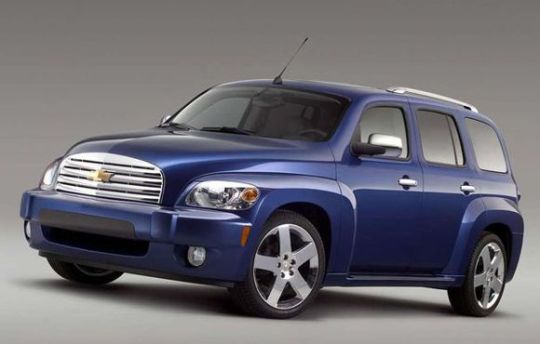
The HHR in my opinion is ugly. The rather boxy look really does not work with the tacked on “retro” elements and it makes the car look tacky as a result. The HHR was inspired by the Third Generation Chevrolet Suburban which I have always thought was a beautiful car (expect a review and maybe even a comparison post between that and the HHR later on).
The HHR does have some homages to the suburban, primarily with it’s rounded roofline and its more modern take on the Suburban’s classic grille. And while we are on the topic of grille’s and front ends of cars, can we acknowledge how the grille of the HHR looks like an afterthought? The front end of the HHR looks slapped on at the last minute. I have always thought that the HHR’s grille looked like a pigs snout.
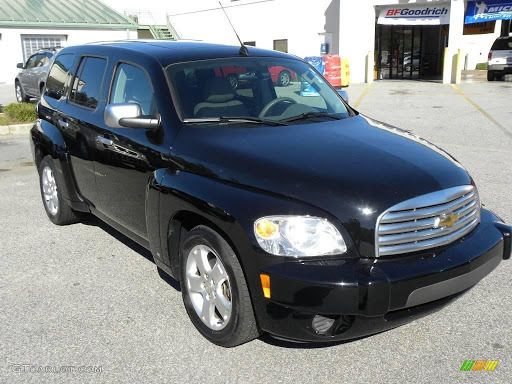
There’s also a problem with this cars design that I have noticed with a lot of GM SUV’s from the early 2000′s and 2010′s and that is the big and ugly rectangular fenders. Yes, the third generation Suburban had large fenders as well. But what separates the HHR and the Third Generation Suburban’s fenders is the fact that the fenders on the Suburban worked well with the grille and the headlights whereas on the HHR the headlights and grille look slammed on while the fenders crudely protrude out of the sides of the car. And as I mentioned before, this is not the only GM SUV to have this problem. The GMC Terrain from this era has this exact same issue! Large fenders can look great, why just look at the Corvette C3 which is one of my favorite ‘vette’s of all time! But the HHR’s boxy fenders aren’t doing it any favors.
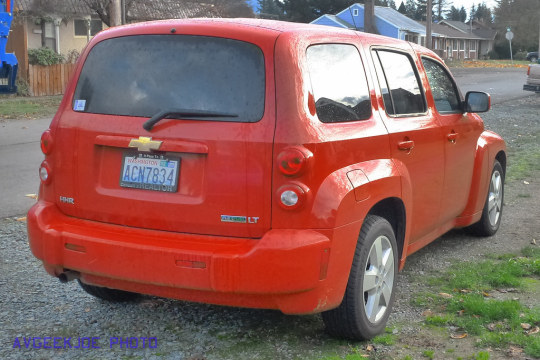
The rear end of the HHR comes with it’s own problems but the main one in my opinion is the taillights. The dual circled taillights are rather ridiculous in my opinion. They look like pimples on the back of the car. However while we are on the subject of the back of the HHR I would like to point out something I actually like about it which is the roofline and overall shape. I feel like the shape and the roofline were a good homage to the Third Gen Suburban and managed to look like a good modern imitation of it. I truly thing that the HHR would be better if it did not look as awkward. GM bolted all sorts of crap on it to make it compete with the PT Cruiser which A: is not winning any beauty contests itself and B: was already considered outdated when the HHR first came out and was discontinued four years later.

And I suppose if I am going to talk about the HHR I am going to have to talk about the PT Cruiser. The PT Cruiser was a retro-styled hatchback introduced to the world by Chrysler in 2001. Contrary to what many people say about the PT Cruiser now, it was initially a huge success, even going on to be declared 2001 Car of the Year by Motortrend. 4 years later when PT Cruiser sales were just starting to decline, GM decided that Chevy needed to create a PT Cruiser rival. Interestingly enough, the PT Cruisers designer Bryan Nesbitt was poached from Chrysler by GM and designed the HHR which is where some of their similarities such as them both sharing headlights on the fenders came from. The only other car I found that is credited to him designing was the Seventh Gen Chevy Malibu which followed the time honored Malibu tradition of being....OK I guess.
And on that note it’s time to get into:
Interior Design:
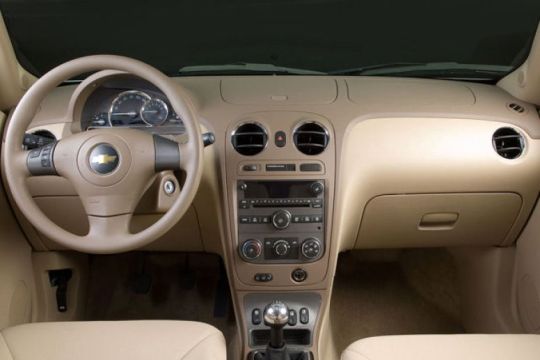
The HHR’s interior is fine. The interior looked at its best in this beige color. When it was black it simply made the HHR’s interior look cheap as hell. But overall the design is pretty simplistic and that is good. It looks very early 2000′s, which depending on who you ask is a good thing or a bad thing. The PT Cruiser had a much worse interior in my opinion. The HHR looks a bit like a more streamlined version of the PT’s interior. Which makes sense since I mentioned that the guy who designed the PT also designed the HHR.

There’s not much else to say about the HHR’s interior, it just looks a bit like a generic Chevy interior. It’s bland but bland is better than overtly ugly like the exterior, and it could have been so much worse. So in that respect the interior is certainly one of the HHR’s more positive points!
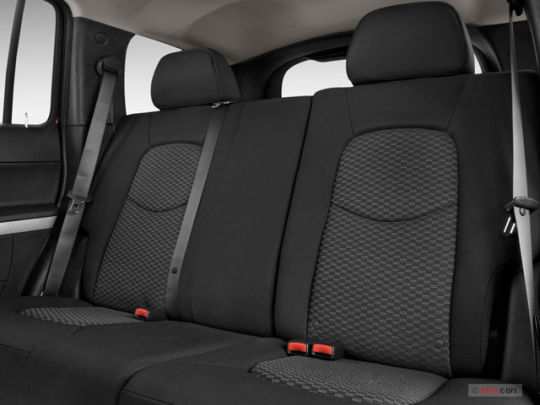
In the back the HHR had a bench seat which looked fine. It serves it’s purpose of hauling extra people and children around/being a decent load floor for cargo when put down. Not much really went on back there which I have no problem with. The HHR isn’t a Rolls Royce, it does not need to have a luxurious back seat!
Variants:

The HHR had a few different versions of it over the years. So here they are;
HHR SS:

This was the performance version of the HHR. It upgraded the HHR’s 155 horsepower to a respectable 260 Horsepower. I will admit that the HHR SS is actually kind of cool when looking at it from a performance standpoint. The HHR SS wasn’t too different from the base model when it came to looks. It got an SS badge on the side and a different looking bumper and grille. On the inside the HHR SS was basically the same as the base-model except the steering wheel had an SS Badge.
HHR Panel Van and HHR SS Panel:

Chevy offered a panel van version of the HHR which looked like what it was, a Chevy HHR that was converted into a panel van. The back windows are completely gone for instance. There was no way to open the panel vans door from the exterior and you instead had to push a button on the key fob to open them (although there was also a button on the dash to open the doors in case that didn’t work).
The weirdest HHR variant however was the SS version of the panel van. That’s right, a crossover turned into a performance car turned into a van. No wonder a cash strapped GM cut this strange version of the HHR off after four months and only 216 units!
Pros And Cons:
Pros:
Decent Cargo room and way more practical than it’s rival the PT Cruiser.
The SS Version is actually quite sporty
Decent Interior
Cons:
Very Ugly
Can look cheap depending on what color you chose
Questionable reliability.
Final Verdict:

The HHR is an example of a retro design that just did not work! It’s certainly not the ugliest car ever made mind you, but it is certainly ugly and awkward. The interior is bland and inoffensive (which is certainly better than bad!).
Exterior Styling Final Rating; 18/50
Interior Styling Final Rating; 21/50
Overall Styling Rating; 39/100.
Next Review: A Modern Luxury Sedan
4 notes
·
View notes
Text
A Family's Hope Is Restored!
New Story has been published on https://enzaime.com/a-familys-hope-is-restored/
A Family's Hope Is Restored!
https://www.youtube.com/watch?time_continue=5&v=_a33x5XgznI
After a fall, 9-year-old Danica was left with metal rods, which had been implanted years before to stabilize her spine and had broken in the accident, floating dangerously close to her brain stem. Danica and her family traveled from Ohio to Johns Hopkins to receive life-altering, complex reconstruction surgery from Neurosurgical Spine Center Director Nicholas Theodore, M.D. Danica is now able to ride a bike for the first time ever.
The first sign of something wrong with Danica Snyder’s spine came at age 13 months, when she cried out in pain when turning her head a certain way during diaper changes. Then, while posing for a family portrait at 18 months old, Danica’s head kept falling to one side.
Danica and her mother share a special moment.
“Everyone said she had torticollis,” says Danica’s mother, Monica Kaye Snyder.
Torticollis, or “twisted neck” in Latin, which can occur due to positioning in the womb, can be corrected with stretching exercises at home. But physical therapy recommended by Danica’s pediatrician was not only not improving her condition, “she was getting worse,” says her mom. She then took Danica to a neurologist near their home in Uniontown, Ohio, who ordered a CT scanof her neck, which offered no clues to her problem. Then, she took her child to another neurologist, who ordered an MRI scan that revealed the culprit.
“We saw the Chiari malformation,” says Snyder, referring to a congenital defect in which brain tissue extends into the spinal canal.
Danica was referred to an Ohio hospital, where pediatric neurosurgeons were surprised to see excess bone along the right side of her cervical spine pulling her head to one side, signs of a rare condition called atlas assimilation. Indeed, vertebrae C2 and C3 were starting to fuse with the base of her skull, a condition no amount of physical therapy could fix. Complicating matters more, her brain stem and cerebellum had already started to drop into her spinal canal, compromising the flow of cerebral spinal fluid (CSF) surrounding and protecting Danica’s skull. The bones at the base of her skull needed to be opened up, a procedure called decompression, to allow for proper flow of CSF.
“There was no flow at all on the right side of her brain,” says Snyder.
Surgical Intervention
Surgeons successfully decompressed Danica, then age 2, but her crossing with Chiari malformation was far from over. Neurosurgeons scanning her six months later found further descent of brain tissue into her spinal canal and instability where the spinal cord meets the brain—the craniovertebral junction (CVJ). She needed to be decompressed again and have her spine stabilized with spinal instrumentation.
Danica underwent another decompression operation, but surgeons recommended she wait until she reached age 6 for fusion surgery. Seeing 3-D imaging of Danica’s Chiari, Snyder says: “I knew that wasn’t the answer. Part of the brain that had fallen was already dead.”
She found a neurosurgeon and spine surgeon who together would do Danica’s fusion surgery. After the surgeons stabilized the CVJ with metal rods and sewed in a cerebellar sling to keep her brain from falling again, they restricted her to a wheelchair and no physical activity for at least six months. Also during that time, she would have to wear a brace 24/7 for at least six months to help immobilize her spine. She ended up wearing it for a year.
“That was a very long journey for a young child to have no motor development activity,” says Snyder. “But we see now how that shaped Danica into who she is—a reader, musician, a functionally bright kid.”
But Danica also wanted to be like other kids, to play with them on the school playground when she was told she would have to sit on the sidelines. One day she said no, walked toward the playground and fell.
“I believe that’s when the hardware broke,” says Snyder.
Indeed, Danica and her mom then heard clicking and popping sounds of metal on metal when Danica moved her head. She lost stability in her spine and, worse, the broken rods were endangering her brain. To further complicate matters, Danica’s last two surgeons had retired. Snyder tried to remain hopeful but knew there were few experts in the country who could manage a very complex patient like Danica.
“I didn’t know where else to go, where to get another opinion,” she says. “We were worried no one would take her case.”
Technological Advancements Guide a Complicated Case
Then, she learned that one of those experts, neurosurgeon Nicholas Theodore, was moving from Arizona to Baltimore and The Johns Hopkins Hospital, which she knew well from working for many years in the Baltimore-Washington area. But he had just arrived and had not even settled into an office.
“He didn’t even have paper clips,” says Snyder. Nonetheless, Theodore’s longtime assistant, Julie Zeuch, said, “Send me Danica’s files.” Then Theodore, who had deep experience treating patients with motor vehicle-related traumatic spine injuries in Arizona, called. “He said, I’m honored and humbled to take this case. This is what I do,” recalls Snyder.
Indeed, Theodore had performed some 150 of these high-risk procedures. But as confident as he was, Theodore knew this revision spine surgery would be no walk in the park. He would be operating on the CVJ, the holy grail of spine surgery, what Theodore calls “high-priced real estate.” And this anatomy had been altered by broken rods and previous surgeries, obstructing his visual field.
“If you haven’t seen this before, from a surgical perspective, it’s kind of daunting,” says Theodore. “It’s like being in the middle of New York City and someone takes your map away and you don’t know where you are.”
To navigate this terrain, he took advantage of intraoperative imaging advances at Johns Hopkins, positioning Danica in an O-arm CT to obtain real-time 3-D images during the procedure.
“In this case, the technology was critical in determining the location of the broken rods, spinal canal and other critical structure all covered in semihealing bone,” says Theodore. “The imaging gave us immediate feedback where everything is.”
The imaging and Theodore’s surgical expertise were important in another regard too. In a previous surgery, the end of a spinal drain catheter had broken off and now threatened Danica’s brain stem. Using the intraoperative CT, Theodore knew exactly where it was and was able to neatly remove it instead of making a large opening in the dura—the membrane covering the spinal canal and brain—exposing the spinal cord and fishing around for it.
“We were able to make a very small opening, dissect the catheter away from the brain stem and take it out,” says Theodore.
To stabilize Danica’s severely unstable CVJ, which posed a risk of pinching her spinal cord and incurring severe neurologic deficits, Theodore meticulously removed and repaired the broken hardware in the six-hour operation. He also harvested a 3-inch piece of the girl’s top rib for additional support. This is natural bone, explains Theodore, which gives patients a higher rate of healing than cadaver bone.
“Also, the rib has a nice curve to it and fits perfectly between the base of the skull and the upper cervical spine,” says Theodore. “It’s as though God invented it as a piece to fill in this piece of the jigsaw puzzle.”
A Collaborative Win
Danica’s outcome?
“The pain she was having before is gone; she’s doing quite well,” says Theodore. “If she does end up having a solid fusion and everything heals perfectly, I think the future is bright for her. I think it is now. I’ve had pretty good luck in these revision operations.”
Theodore adds that the credit for such outcomes goes to the diverse skills and collaboration of Johns Hopkins’ surgical teams.
“This case underscores our different expertise and team approach history. It’s not one guy doing everything,” says Theodore. “This is one of those areas—complicated spinal problems—where we come together for the benefit of the patient. That type of collaboration is another reason I’m here.”
For Snyder, Danica’s recovery “was everything we had hoped for. She had zero pain after her surgery, and now she’s doing so well. We’ve had amazing support in the community and at school. She’s very loved.”
She attributes her outcome not only to Theodore’s surgical skills, but also to the way he interacted with Danica and infused her with confidence.
“The day before her surgery, Dr. Theodore came into Danica’s room and went right to her and spoke to her like there was no one else in the room. He asked her how she was feeling and talked about her operation, which gave her a lot of confidence going into the surgery,” says Snyder. “He made all the difference in restoring a childhood that she honestly never had.”
0 notes